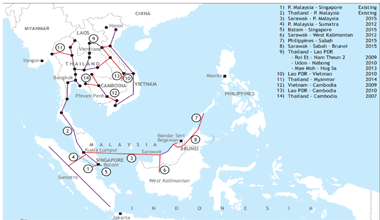Laos has been working with its ASEAN colleagues to push for energy security and affordable power to promote industry growth and drive development, a senior Lao government official told local and foreign experts and editors this week.
Deputy Minister of Energy and Mines, Mr. Viraphonh Viravong made the comments at the 5th ERIA (Economic Research Institute for ASEAN and East Asia) Editors’ Roundtable under the theme “Turning Vision into Reality for a Dynamic ASEAN Community” held on Monday in Vientiane.
ASEAN energy ministers have engaged in talks seeking ways to address common challenges by ensuring energy security, making power more affordable and ensuring the sustainability of the sector, he said.
The deputy minister stated that the region needs energy for the development of other activities, saying that cooperation to ensure the most effective cost for energy development is essential to cut production costs and increase competition capacity.
“If it [energy] is too expensive, we cannot be competitive. We cannot attract other industries,” he told the participants.
The meeting, which was co-organised by ERIA, the Lao Journalist Association and Vientiane Times, brought together more than 30 experts, economists and editors from ASEAN member countries and ASEAN dialogue partners to share views on how ASEAN’s vision can be pursued and the challenges ahead.
To make energy, specifically electricity more affordable, the minister noted that there are two key ways of doing so – the development of larger scale hydroelectricity plants and ensuring the interconnectivity of the energy network.
In the context of Laos, he gave the example of the 1,000 MW Nam Theun 2 Hydropower Project, the construction of which was completed a few years ago.
Some 90 percent of the power generated is exported to Thailand. Power from Nam Thuen 2 is also sold locally at about two and a half US cents per kilowatt hour instead of about six US cents per kilowatt hour if a smaller-scale hydropower plant is developed instead.
In addition, interconnectivity with neighbours has proven to be the most cost effective method for reducing energy costs.
For instance, Laos has exported energy to Thailand, but imports power back for domestic use in some localities which are far away from the existing power grid network.
The reason for this is that the investment for installing long-line networks would be very costly compared to the number of end users.
“This has formed a national energy policy for Laos to make things available and affordable. Power integration really brings down the cost a lot,” he said.
He added that power integration cooperation will benefit countries in the region, given that Laos and Myanmar have potential to develop hydropower electricity – a renewable form of energy. According to the plan, Laos is expected to develop 10,000 MW of electricity by 2020, which will rise further to 20,000 MW by 20 30 – a figure that will be in excess of domestic demand. Some 12,500 MW of hydropower from Laos would keep 30-60 tonnes of carbon dioxide from ebeing mitted annually, according to the deputy minister.
In addition, future demand can be met from wheeled electricity. Given that cooperation can be made to utilise greener-sourced energy, “Why do you have to burn your coal or gas now?” Mr. Viraphonh asked.
He told the meeting that Laos, Thailand, Malaysia and Singapore have engaged in talks to initiate a pilot project, in which Laos plans to sell 100 MW of power to Singapore via Thailand and Malaysia’s power grid network.
Source: Vientiane Times



